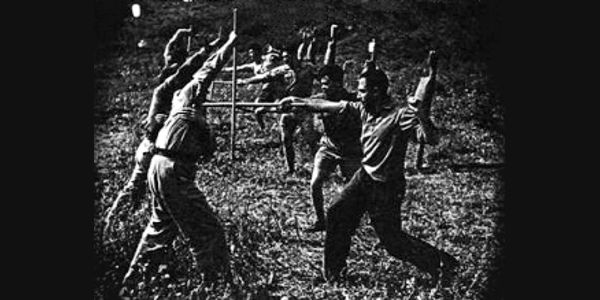It was winter, Jan 1941; WWII had been raging across the globe since September 1939.
In a little room in Palestine two men sat down to discuss the curriculum for an upcoming Course of Kapap (1) instructors for the “Hagana” (2), the first of its kind to take place. Rafa (3) the commander of the course, an advocate of British discipline was questioning the 21 year old Maishel sent to him to teach his short stick fighting method (4).
Rafa: Where did you learn this?
Maishel: We didn’t, we developed it on our own!
Rafa: How can it be, systems have a history, a tradition, something scientific, there must be some materiel about this, I want you to find documentation!
After several days of diligent searching it was Rafa who found a little red book at the library of the Hebrew university in Jerusalem.
In the room again with Maishel, he handed him the book: here, this is something with history, a real method something from India.
Rafa: I want you to take this and study it.
Maishel: I don’t read English.
After Rafa had the book translated, Maishel and a fellow instructor in the short stick method, spent three days, in Tel-Aviv practicing the new method described in the book, The Walking Stick Method of Self Defense (5) , and then returned to Rafa.
Maishel told Rafa, he felt that the short stick system was better suited for their goal of teaching large numbers of students in short time periods to use a stick combatively, because in order to achieve the articulation in the wrist and accuracy which the walking stick demanded, longer periods of training would be necessary and therefore he would prefer to teach the short stick system.
To which Rafa answered, I’ll send you two men from the market, and you train them, then we will decide what to teach.
Rafa sent them Moshe Tzadok who worked at the market and Motke who did dirty work on behalf of one of the Hagana Commanders.
After successfully teaching these two laymen it was decided that both systems would be instructed at the course.
The course was three weeks long, and in addition to teaching the two separate stick-fighting methods, the participants received instruction in boxing, Jujitsu, knife, and stone throwing.
A very competitive atmosphere accompanied the training in the course centered on the stick-fighting methods.
As Maishel recounted : “those who first learned the short stick methods became advocates of that system, while those who were first introduced to the long stick became advocates of that system, whatever one learns first, that is what one thinks is the best”.
The 60 participants had been divided in to groups of twelve and instructed in both systems.
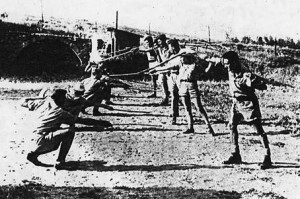
Rafa who discovered the book about the Walking stick method had an interest in it wining a prominent place and so when dividing up the groups sent two groups made up of the prominent commanders to first receive instruction in the Walking stick (6) method.
At the end of the course, Yaakov Dori, The Commander in chief of the Hagana came to observe the training, along with a few other prominent figures.
The less known young men of the groups who trained first in the short stick method wanted to prove their skill and went at each other full force, breaking many of the short sticks in their hands.
Dori was deeply disturbed by this and at a meeting later in the day, decided that for safety reasons the Hagana will only teach the walking stick.
And so the H.G.. Lang / Vigny method of the walking stick came to be officially adopted by the Hagana.
Between 1941 and 1948 tens of thousands, and perhaps even over a hundred thousand, of members of the Jewish community in Palestine (7) and abroad had received instruction in the walking stick method on a regular basis.
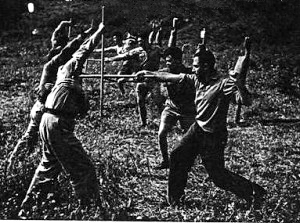
Among those receiving instruction in the system, the youth of the community were in the Majority.
Through the Gadna (8) founded in 1940, all the youth of the community received instruction from the age of 15 to 18, the age at which they joined the Hish (9) where they continued their practice of the walking stick fighting method as a supplement to their training in modern weaponry and company tactics.
The system quickly spread throughout the Jewish community all over Palestine in the Gadna, youth movements, Palmach (10) , and the agricultural communities.
First and foremost amongst the reasons the walking stick method was so popular, was the relative safety of training in it while cultivating bravery in the practitioner, an essential element in a soldier.
This is not to say there were no injuries while training rather that relative to the short stick which was thicker and practiced at a closer range the walking stick seemed safer to the commanders of the Hagana. In fact many veterans of the Hagana and the Palmach had reported in interviews, that hand injuries were very frequent as well as bruises and cut’s to the face. Protective gear was unheard of, and even if it was something perhaps available in Europe it simply was not within the scope of the material means available to the “Hagana”.
Yehiel Litner, an instructor of the walking stick method in the Hagana, told of how while in High school at a agricultural boarding school he instructed the method to the younger classes, he noted that the training sessions in the walking stick method and the Jujitsu classes were used as a means of weeding out the fainthearted from the participants in squad leaders course; those who did not handle the stress well had to drop out.
Another veteran, Ben Ami Reevlin had this to say : those were times of scant means, and great innovation” in order to explain the creation of the short stick method, Kapap and many other things in the activity of the community with regard to security and self defense. Before beginning their training youths were expected to go out and prepare their own walking stick.
The most popular types of wood used were from citrus trees, especially lemon trees and a certain type of orange tree.
At the base of the tree one will often times find young branches sprouting straight up, they tend to be very straight and rather smooth, it was these most sought after branches, that they took and peeled, before hardening them over a fire.
In some cases for unites of the Palmach and Hish sticks were mass produced.
The publication of the third “white papers” by the British McDonald commission in 1939 (11) , convinced the Hagana High command and the leaders of the Jewish community that they were headed for difficult times in which the British would downgrade the level of cooperation with the Jewish community in Palestine and intensify its fight against the Hagana, therefore it would be prudent to bring all underground activity down to a minimum, leaving only the essentials they could not do without and the rest of the activity will be done by the youth who will receive Para-military education through the school system; all youth between ages 16 and 18, both male and female were called on to participate.
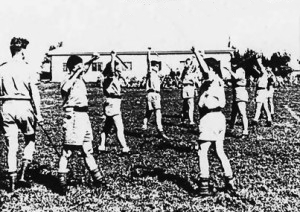
A number of factors had come together to make the stick the weapon of choice at the time.
Under the British mandate it was forbidden to carry weapons and from 1945 on, illegally carrying weapons could send the offender to jail for many years and using them was punishable by death.
A walking stick, on the other hand, can be carried in the open without fear of arrest and at the same time it could easily be turned into a weapon of defense when the need arises.
One major component in the education and preparation of the youth for “military” service was, scouting, in order for them to get to know their country, develop a bond with it and develop endurance for long walks, as well as survival skills.
These long hikes, sometimes lasting days were done out in the undeveloped countryside away from the cities.
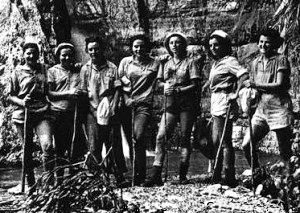
Often times the hikers passed by Arab villages or Bedouin camps, where the danger of an encounter with hostile population was real.
When such encounters did occur, the attackers usually employed as their weapons, sticks of varying lengths, commonly found in the hands of shepherds and workers in the field, ranging from one to three meters long. In these situations the walking stick came in handy and was used for defense. Most of the time, the fact that the holder of the stick showed a will to fight and skill while swinging it led to a retreat or stand down on the side of the attackers.
The fact that most confrontations were with Arabs armed with clubs was addressed by adding those clubs to the weapons one learned how to defend against.
This applied to the practice of the Walking stick as well.
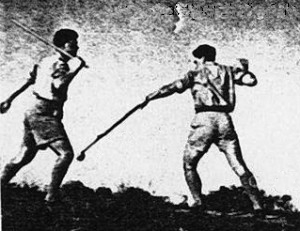
Since the walking stick was initially taught to instructors by Maishel the developer of the short stick method, the idea of charging at the attacker preparing for a head strike was added as well. When asked about the influences both systems may have had on each other in Israel, he replied that the attitude with which they practiced the short stick was infused into the practice of the walking stick; meaning that one was focused on closing with the opponent and neutralizing him at close range.
Originally the purpose of the stick was to enable opposition of the British police when marching in protest. To my knowledge there are no known instances where this actually happened with people trained in the stick fighting methods, though on one occasion in 1942 while Maishel and a group of youths had returned to Jerusalem , from a long march down to Masada (12) by the Dead Sea , a confrontation with Australian soldiers did take place.
As Maishel and his friends were crossing the street, they heard someone crying, they then saw a wagon driver, driving a small wagon and horse carrying a number of drunken Australian soldiers who were harassing him.
Maishel approached them and asked them to leave the wagon driver alone.
The soldiers did not take to this kindly and one of them dismounted and started walking towards Maishel. In response Maishel started swinging his walking stick to keep the soldier at a distance. After a few flicks the soldier charged at Maishel, tackled him and took him to the ground. They wrestled for some time until someone walked over to Maishel, kicked him on the butt and told him to leave the soldier alone.
The crowed who had gathered as this took place cheered for Maishel and some walked over to congratulate him on his bravery. Maishel teaching the late Yitzhak Rabin, 1941.
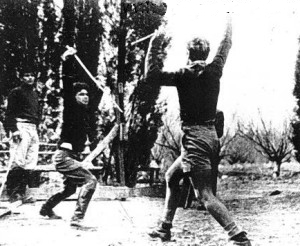
The relatively passive stance that the “Hagana” maintained towards Arab aggression in the early 30’s and the adoption of the “Havlaga”, meaning to exercise self restraint, in response to the continuous attacks on Jews by Arabs during the Arab uprising of 1936-39, was the cause of much frustration within the community, eventually leading to the formation of two renegade undergrounds, the Etzel (13) and Lehi (14) whose purpose was to retaliate against the Arab attacks. Many youth flocked to these renegade underground groups, after being disappointed with the Hagana’s relative passivity. A rift had opened in the community accompanied by much friction between supporters of the opposing sides. The Hagana was concerned about losing the support of the “street” and engaged in continual active opposition of the renegade undergrounds on the streets, through the youth. Fights between activists of the opposing parties often times came to blows, and on occasion sticks were used in these altercations.
During WWII and after it ended a flood of Jewish refugees had set out towards Palestine . The British, whom had passed laws limiting immigration to Israel in 1939, set up 6 internment camps in Cyprus to which they deported the thousands of illegal immigrants they intercepted at sea and on the beaches of Palestine . Sensing the despair of the detained refugees, the Hagana set up shop in the camps to help boost moral through organized activity, including smuggling out hundreds of young men.
One of the programs was mandatory training, requiring every one between the ages of 16 and 60 to participate in a two week long training program in which they were taught the walking stick method of defense among other things. The “Hagana” used this overt activity to hide their more important secret weapons training for the young detainees, knowing the British would view this activity of Stick fighting exercises as sports and therefore think they were busy with harmless activities.
Even in the camps the struggle between the undergrounds continued and on occasion fights involving stick broke out.
With WWII ending in 1945, it became possible for the Hagana to send representatives to Europe in order to prepare the refugee survivors of the Holocaust for immigration to Israel, and for them to be able to defend themselves in case anti-Jewish riots broke out in Europe. Thousands of youths all over Europe , received tuition in the walking stick fighting method of self defense in these training camps.
After the war of independence 1948, and formation of the state of Israel , the Gadna continued its activity as a training program through the schools, preparing teenagers for their mandatory military service upon turning 18.
It was decided that the walking stick method would continue to be taught as a means of cultivating bravery, and so we find the system being taught well into the sixties and in some instances even the early seventies of the twentieth century.
Interestingly, though, all this activity did not result in any kind of civilian practice of the system in the form of a martial art practiced regularly outside of the Gadna.
Sadly these long years of instructors passing on their knowledge and skill did not breed experts or masters of the stick and so after nearly 30 years of teaching the walking stick method in Israel, the method had once again faded into the mists of time, only to be fondly recollected with a smile by adults taking a walk down memory lane recounting long days gone by when in their youth out in the school courtyard they used to swing a stick.
1. Kapap stands for Krav panim-el-panim, literally translates into face-to-face combat. A variety of disciplines were taught under this heading, among them: Judo, Jujitsu, Boxing, Knife, stone throwing and the Walking stick and short stick methods. With time the name came to be associated primarily with the stick fighting methods.
2. Hagana means defense. This was the name of the Jewish community’s national underground founded in 1920 with the purpose of forming a nation wide body that would be able to defend the members of the Jewish community in Palestine be they in the city or on the farms out in the country side.
3. Rafa, Rafael atlas was a commander in the Hagana, and was an expert at drill. He was in charge of the first Kapap course for the Hagana.
4. Maishel Horowitz was a councilor in the youth movement called Hamahanot Haulm, in 1940 he developed a method of stick fighting utilizing a 62cm long club. This system was supposed to enable members of the youth movement participating in the massive protesting taking place in 1940, to defend themselves against the British police’s clubs. After proving its worth in a large scale skirmish involving hundreds of participants, with Arab villagers in a land dispute, the Hagana took notice of Maishel and his system.
5. The Walking Stick Method of Self-Defense, written by H.G. Lang, detailing his version of the Pierre Vigny system, published around 1926
6. For the sake of clarity I will use the term walking stick method when referring to the system taught in Israel based on H.G. Lang’s book, when in actuality almost no one used this name for the system, it was simply known as the long stick system. The systems name and origin were known to few, and even among them, most thought it was of Indian origin.
7. Palestine , refers to the land under British mandate as was defined and named at the U.N. in 1917, this included what was later renamed TransJordan.
8. Gadna: Gduday Hanoar, the youth brigades were formed in 1941 in answer to the need to prepare the youth of the Jewish community in Palestine , for war, before they join the Hagana.
9. Hish, heil hasade, or field unit, was the next step for the 18 year olds Graduating from the Gadna. These were units of the Hagana who’s purpose was to be a trained force capable of conducting a none stationary engagement outside of the city or settlement boarders.
10. Palmach, plugot Hamahatz, the crush platoons, were the first full time soldiers of the Hagana, initially set up in cooperation with the British in anticipation of a German invasion of Palestine . The members were trained as an elite unit and used guerilla tactics, it later served as the foundation for the formation of the IDF.
11. In 1939 in the wake of the Arab uprising of 1936-39 the British had set up the McDonald commission to investigate the cause of the uprising. The result was a paper presenting a partition plan dividing Palestine in to two separate states, one for the Jews, and one for the Arabs. Draconian laws limiting emigration of Jews to Israel , keeping the Jewish population down to a third of the total population in Palestine , and a prohibition on the sale of Arab owned land to Jews were recommended and enacted. The “white paper” of 1939 made it Clear to the Jewish leaders that the British empire felt that it had completed its obligation to a Jewish state as promised in the Balfor declaration of 1917 and the bill of mandate itself. The publication of the new laws, brought out the entire Jewish community, on to the streets in protest. The British police responded violently, riding horses into the crowd and cracking heads freely with their clubs.
12. Masada , a fortress on top a flat mountain, by the Dead Sea , built by king Herod for his summer palace. Josephus Flavius in his “The Jewish war” tells us of a great siege by the Romans and a mass suicide of the besieged. It has become a national symbol fighting to the bitter end.
13. & 14. Etzel or IZL, “irgun tzvai le’umi”, the National Military Organization, founded in1931 in a split from the Hagana, was supported by the revisionist movement headed by Jabotinsly, and Lehi, “lohamei herut Israel “, Israel freedom fighters, founded in 1940 after splitting off from the IZL, were both renegade undergrounds actively and violently opposing the British mandate forces, in the hope of causing them to leave Palestine . Initially it was formed with the purpose of retaliating against the Arab attacks on the Jewish community the former in the early 30’s and the latter after the uprising of 1936-39. Up until 1945, this activity was contrary to the line the Hagana and leaders of the community had taken up in the belief that the British would help the Jews in Palestine , achieve statehood even if slowly and with much difficulty.
Photographs # 1, 2, 3, 5 are the property of the Hagana Archives, # 4 is from the Palmach album and # 6 is from Maishel Horowitz and the Palmach Archives.
This article is based on material collected for an upcoming book about the stick fighting methods of Kapap and draws mostly on interviews conducted with Maishel Horowitz during the years 2002 and 2003.
The Author: Noah Gross lives and practices martial arts in Israel , and is currently completing the research and writing of his book about Kapap. He can be contacted through e-mail at: noahsarc@netvision.net.il (No part of this article or in its entirety is to be published online or any other form without the permission of Noah Gross
Warning – These articles are for historical information and academic study only. USADOJO.COM will not be held responsible for the use or misuse of information contained herein.

